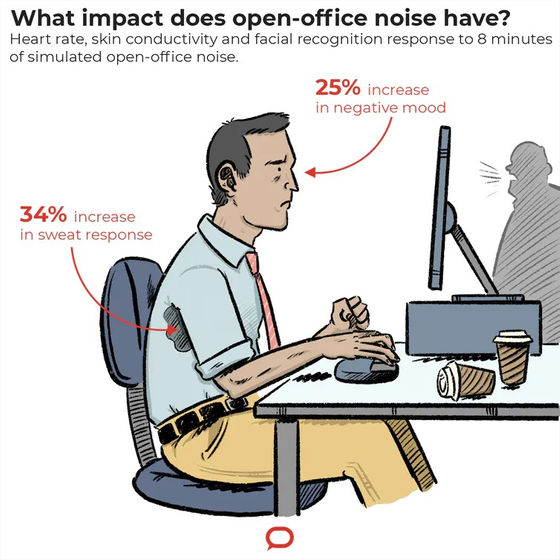Research results show that noise amplifies negative mood by 25% in 'open office' without partitions

The 'Open Plan Office (Open Office) ', which divides the desk with storage and panels and does not provide a partition to the ceiling throughout the office, promotes communication between employees and collaboration across departmental boundaries. , The office layout adopted by many companies. Regarding such open offices, Associate Professor Libby Thunder of Bond University, who is studying the effects of work environment on cognition and performance, warns that 'open offices increase stress and make you feel sick.'
Open-plan office noise is stressful: multimodal stress detection in a simulated work environment | Journal of Management & Organization | Cambridge Core
Open-plan office noise increases stress and worsens mood: we've measured the effects
https://theconversation.com/open-plan-office-noise-increases-stress-and-worsens-mood-weve-measured-the-effects-162843
Pre-Corona (PDF file) Open Office is such a common office layout that a 2014 survey found that '70% of people working in the office work in the open office.' However, there are problems in open offices such as 'the chattering voice and the sound of typing on a PC are noisy and I can't concentrate' and 'people moving around the office come into view and get distracted'.
Why do you get distracted, tired, and sowed in Open Office?-GIGAZINE

By Kenny Louie
In order to quantitatively investigate the effect of such open offices on workers' psychology, Assistant Professor Thunder and his colleagues have used two types of office layouts, an 'open office' with no partitions and a 'private office' with private rooms. We conducted an experiment in which people were asked to continue pseudo work (text proofing work) in the noise of printing sounds, ringtones, keyboard typing sounds, and so on. The stress that the subject received from the environment was measured from the heart rate and other factors.
In this experiment, not only the heart rate and sweating amount, which are indicators of physiological stress, were recorded with a sensor, but also the change in stress from facial expressions was quantified by facial expression recognition software, and the self called Positive and Negative Affect Schedule (PANAS). The subjective feelings of the subjects were examined by an evaluation-type questionnaire. As a result, it was found that the sweating amount of the subject increased by 34% and the stress calculated from facial expressions etc. increased by 25% by continuing to work for only 8 minutes in the open office environment.

According to Associate Professor Thunder, in similar studies conducted in the past, subject stress was measured only by a self-assessment questionnaire. In addition, in the past research, there was a problem that the control experiment was not performed and the type and volume of noise were not controlled, but in this experiment, the order of noise reproduction was changed and the bias due to the influence of fatigue and training. Thunder argues that he avoided the problem and proved a direct causal relationship.
Regarding the results of this experiment, Associate Professor Thunder said, 'Noise does not cause immediate physical harm, but continuous exposure to noise throughout the day can have a significant effect.' 'Physiological stress is chronic. Increased levels are known to be detrimental to both mental and physical health, and frequent negative moods can adversely affect job satisfaction and commitment and employees. Increases the likelihood that employees will retire. '
Related Posts:
in Science, Posted by darkhorse_log






